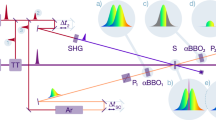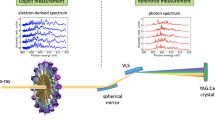Abstract
Short-wavelength free-electron lasers are now well established as essential and unrivalled sources of ultrabright coherent X-ray radiation. One of the key characteristics of these intense X-ray pulses is their expected few-femtosecond duration. No measurement has succeeded so far in directly determining the temporal structure or even the duration of these ultrashort pulses in the few-femtosecond range. Here, by deploying the so-called streaking spectroscopy technique at the Linac Coherent Light Source, we demonstrate a non-invasive scheme for temporal characterization of X-ray pulses with sub-femtosecond resolution. This method is independent of photon energy, decoupled from machine parameters, and provides an upper bound on the X-ray pulse duration. We measured the duration of the shortest X-ray pulses currently available to be on average no longer than 4.4 fs. Analysing the pulse substructure indicates a small percentage of the free-electron laser pulses consisting of individual high-intensity spikes to be on the order of hundreds of attoseconds.
This is a preview of subscription content, access via your institution
Access options
Subscribe to this journal
Receive 12 print issues and online access
$209.00 per year
only $17.42 per issue
Buy this article
- Purchase on Springer Link
- Instant access to full article PDF
Prices may be subject to local taxes which are calculated during checkout





Similar content being viewed by others
References
Friedrich, W., Knipping, P. & Laue, M. Interferenzerscheinungen bei Röntgenstrahlen. Ann. Phys. (Leipz.) 346, 971–988 (1913).
Madey, J. M. J. Stimulated emission of Bremsstrahlung in a periodic magnetic field. J. Appl. Phys. 42, 1906–1913 (1971).
Huang, Z. & Kim, K.-J. Review of X-ray free-electron laser theory. Phys. Rev. Spec. Top. Accel. Beams 10, 034801 (2007).
Galayda, J. N., Arthur, J., Ratner, D. F. & White, W. E. X-ray free-electron lasers—present and future capabilities [Invited]. J. Opt. Soc. Am. B 27, B106–B118 (2010).
Emma, P. et al. First lasing and operation of an ångstrom-wavelength free-electron laser. Nature Photon. 4, 641–647 (2010).
Bonifacio, R., Pellegrini, C. & Narducci, L. M. Collective instabilities and high-gain regime in a free electron laser. Opt. Commun. 50, 373–378 (1984).
Ehrke, H. et al. Photoinduced melting of antiferromagnetic order in La0.5Sr1.5MnO4 measured using ultrafast resonant soft X-ray diffraction. Phys. Rev. Lett. 106, 217401 (2011).
Eichberger, M. et al. Snapshots of cooperative atomic motions in the optical suppression of charge density waves. Nature 468, 799–802 (2010).
Kwon, O.-H. & Zewail, A. H. 4D electron tomography. Science 328, 1668–1673 (2010).
Hoener, M. et al. Ultraintense X-ray induced ionization, dissociation, and frustrated absorption in molecular nitrogen. Phys. Rev. Lett. 104, 253002 (2010).
Fang, L. et al. Double core-hole production in N2: beating the auger clock. Phys. Rev. Lett. 105, 083005 (2010).
Young, L. et al. Femtosecond electronic response of atoms to ultra-intense X-rays. Nature 466, 56–61 (2010).
Kanter, E. P. et al. Unveiling and driving hidden resonances with high-fluence, high-intensity X-ray pulses. Phys. Rev. Lett. 107, 233001 (2011).
Neutze, R., Wouts, R., van der Spoel, D., Weckert, E. & Hajdu, J. Potential for biomolecular imaging with femtosecond X-ray pulses. Nature 406, 752–757 (2000).
Johansson, L. C. et al. Lipidic phase membrane protein serial femtosecond crystallography. Nature Methods 9, 263–265 (2012).
Seibert, M. M. et al. Single mimivirus particles intercepted and imaged with an X-ray laser. Nature 470, 78–81 (2011).
Ackermann, W. et al. Operation of a free-electron laser from the extreme ultraviolet to the water window. Nature Photon. 1, 336–342 (2007).
Shintake, T. et al. A compact free-electron laser for generating coherent radiation in the extreme ultraviolet region. Nature Photon. 2, 555–559 (2008).
Pile, D. X-rays: first light from SACLA. Nature Photon. 5, 456–457 (2011).
Ding, Y. et al. Measurements and simulations of ultralow emittance and ultrashort electron beams in the Linac coherent light source. Phys. Rev. Lett. 102, 254801 (2009).
Krinsky, S. & Gluckstern, R. Analysis of statistical correlations and intensity spiking in the self-amplified spontaneous-emission free-electron laser. Phys. Rev. Spec. Top. Accel. Beams 6, 050701 (2003).
Düsterer, S. et al. Femtosecond X-ray pulse length characterization at the Linac Coherent Light Source free-electron laser. New J. Phys. 13, 093024 (2011).
Ding, Y. et al. Femtosecond X-ray pulse temporal characterization in free-electron lasers using a transverse deflector. Phys. Rev. Spec. Top. Accel. Beams 14, 120701 (2011).
Grguraš, I. et al. Ultrafast X-ray pulse characterization at free-electron lasers. Nature Photon. 6, 852–857 (2012).
Frühling, U. et al. Single-shot terahertz-field-driven X-ray streak camera. Nature Photon. 3, 523–528 (2009).
Itatani, J. et al. Attosecond streak camera. Phys. Rev. Lett. 88, 173903 (2002).
Kienberger, R. et al. Atomic transient recorder. Nature 427, 817–821 (2004).
Hentschel, M. et al. Attosecond metrology. Nature 414, 509–513 (2001).
Kruit, P. & Read, F. H. Magnetic field paralleliser for 2π electron-spectrometer and electron-image magnifier. J. Phys. E 16, 313–324 (1983).
Gagnon, J. & Yakovlev, V. S. The direct evaluation of attosecond chirp from a streaking measurement. Appl. Phys. B 103, 303–309 (2011).
Drescher, M. et al. Time-resolved atomic inner-shell spectroscopy. Nature 419, 803–807 (2002).
Schins, J. et al. Observation of laser-assisted Auger decay in argon. Phys. Rev. Lett. 73, 2180–2183 (1994).
Glover, T., Schoenlein, R., Chin, A. & Shank, C. Observation of laser assisted photoelectric effect and femtosecond high order harmonic radiation. Phys. Rev. Lett. 76, 2468–2471 (1996).
Gagnon, J. & Yakovlev, V. S. The robustness of attosecond streaking measurements. Opt. Express 17, 17678–17693 (2009).
Glownia, J. M. et al. Time-resolved pump–probe experiments at the LCLS. Opt. Express 18, 17620–17630 (2010).
Bozek, J. D. AMO instrumentation for the LCLS X-ray FEL. Eur. Phys. J. Spec. Top. 169, 129–132 (2009).
Emma, P. et al. Femtosecond and subfemtosecond X-ray pulses from a self-amplified spontaneous-emission-based free-electron laser. Phys. Rev. Lett. 92, 074801 (2004).
Acknowledgements
Portions of this research were carried out at the Linac Coherent Light Source (LCLS) at SLAC National Accelerator Laboratory. LCLS is an Office of Science User Facility operated for the US Department of Energy (DOE) Office of Science by Stanford University. The work was partly supported from the German cluster of excellence ‘Munich-Centre for Advanced Photonics’. W.H., W.S. and R.K. acknowledge financial support by the BACATEC programme. W.H., A.R.M. and W.S. acknowledge ‘The International Max Planck Research School on Advanced Photon Science’ for funding and continued inspiring support. W.H. acknowledges financial support from a Marie Curie fellowship. A.R.M. thanks S. Reiche for fruitful discussions and help with GENESIS simulations. C.R. and G.D. acknowledge partial support from the US DOE (DE-FG02-04ER15614) and the National Science Foundation (NSF; PHY-1004778). G.D. also acknowledges support from US Department of Energy/Basic Energy Sciences (US DOE/BES; DE-AC02-06CH11357). J.T.C. acknowledges support from Science Foundation Ireland (grant no. 12/IA/1742). R.K. acknowledges funding from an European Research Council Starting Grant. The authors thank T. Schätz for comments on the manuscript. The authors thank P. Emma, Y. Ding, J.B. Hastings and W. White for their support, C. Behrens and H.-D. Nuhn for their expertise and advice on FEL-related questions, and to the whole scientific and technical team at LCLS for their dedication and unrelenting work during our beam time, in particular to the machine operators.
Author information
Authors and Affiliations
Contributions
W.H. and A.R.M. contributed equally to the work. R.K. developed the concept. W.H., A.R.M., W.S., I.G., P.R., G.D., C.R., J.G., Ma.M., S.S., C.B., L.F.D., J.D.B., R.C., A.L.C. and R.K. designed the experiment and contributed to the preparation of the experimental set-up. W.H., A.R.M., W.S., I.G., P.R., G.D., C.R., Ma.M., S.S., C.B., D.C., J.D.B., Th.T., J.T.C., Mi.M., R.C., S.D., A.L.C. and R.K. performed the experiment. W.H., A.R.M., W.S., I.G., P.R., G.D., J.G., A.L.C. and R.K. analysed the data. W.H., A.R.M., G.D., J.G., F.G., L.F.D., Th.T., J.T.C., Mi.M., S.D., A.L.C. and R.K. wrote the paper.
Corresponding author
Ethics declarations
Competing interests
The authors declare no competing financial interests.
Supplementary information
Supplementary information
Supplementary information (PDF 5388 kb)
Rights and permissions
About this article
Cite this article
Helml, W., Maier, A., Schweinberger, W. et al. Measuring the temporal structure of few-femtosecond free-electron laser X-ray pulses directly in the time domain. Nature Photon 8, 950–957 (2014). https://doi.org/10.1038/nphoton.2014.278
Received:
Accepted:
Published:
Issue Date:
DOI: https://doi.org/10.1038/nphoton.2014.278
This article is cited by
-
Clocking Auger electrons
Nature Physics (2021)
-
Water-Window X-Ray Pulses from a Laser-Plasma Driven Undulator
Scientific Reports (2020)
-
Core-level nonlinear spectroscopy triggered by stochastic X-ray pulses
Nature Communications (2019)
-
The ultrafast X-ray spectroscopic revolution in chemical dynamics
Nature Reviews Chemistry (2018)
-
Attosecond time–energy structure of X-ray free-electron laser pulses
Nature Photonics (2018)



